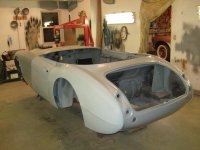As per Mark, yes the oil flows well and fills the cavities, but of coarse you want to make sure all your paint work is done before you let any oil get near the car. My final decision to use good old fashion enamel paint is because it also flows well and sticks to about anything. As an example is if you have ever dropped a tablespoon full of enamel paint on the garage floor or on some surface, unless the surface was really dirty, then later after it dried came back to clean it up you must then get ready for some mighty good scraping with a paint scraper or such as well as some judicious use of lacquer thinner or other such chemical loosening agent. It just doesn't want to come off. That's the way it will stick and coat the inside of your panels if you spray it in there. One good example is more than 20 years ago I restored an MG Midget for a fellow in Massachusetts. It was a '74 I think with the rounded rear wheel arches. I had to fabricate those wheel arches because no commercial patch pieces available.
After I finished the fabrication and welding and even finished the paint job I then sprayed spray bomb can enamel into the back side of the fender panels from the trunck area. I coated the panels and the wheel wells heavily with the enamel till it ran down the inside of the trunk and into the seams and dripped on the floor. This past summer I was up visiting him and he still owns the Midget. The body is without blemish the rear fenders look as good as the day I finished painting them. And over the last 20 years his 3 sons have grown up thrashing that car every chance they could.
One caveat to this method is that even tho I am sold on using enamel for this purpose, Enamel and base colour of a base coat/clear coat system don't like each other. Base Colour will lift enamel. Clearcoat does not have a negative effect on enamel but the base colour does. That is why I spray the inside enamel coating after I finish my painting with base/clear. You just have to take precautions as to where the over spray might land and cover up any surface you don't want overspray on. If you spray enamel paint into your inner panels and voids before you do you basecoat/clearcoat painting and the enamel drips out the seams, and the enamel is visible or you might say reachable with the base coat, the basecoat will craze the edge of your panels. Of coarse a big NO, NO. So you can't let the basecoat get on top of the enamel, but you can let the enamel get on top of the basecoat. Sorry to belabor this but it is a fine point that is very important.

 Hi Guest!
Hi Guest!

 smilie in place of the real @
smilie in place of the real @
 Pretty Please - add it to our Events forum(s) and add to the calendar! >>
Pretty Please - add it to our Events forum(s) and add to the calendar! >> 

